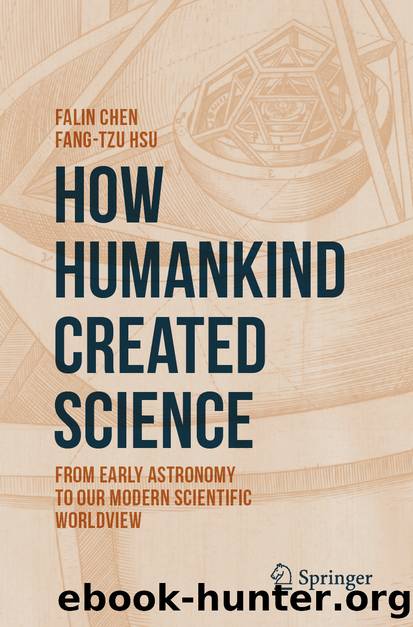How Humankind Created Science by Falin Chen & Fang-Tzu Hsu

Author:Falin Chen & Fang-Tzu Hsu
Language: eng
Format: epub
ISBN: 9783030431358
Publisher: Springer International Publishing
(4.29)
In the function above, is the angular speed of Earth’s rotation, R its radius, g the gravitational constant, and the angle of any circle of latitude.
Based on the result of (4.29), the difference between the equatorial and polar radiuses is about 11 km, registering a 50%+ deviation from the actual measurement of 23 km. As for the reason behind such a significant difference, there are a couple of factors that can explain the result. First of all, let’s not forget that this proposition is a simplified model that only considers the influence of the centrifugal force from Earth’s rotation. The other possible explanation is that the deformation of Earth’s surface is in fact highly irregular, with some people claiming the Earth is a potato-shaped body with unevenly-distributed density. Both these factors could have contributed to the deviation, but the measurements of the French Academy and our calculation can both prove the validity of Newton’s theory that Earth is a flat orb.
The second examination was conducted because of the publisher of the Principia, Halley. As previously discussed in Sect. 4.5, in 1705, Halley sorted through data on the cometary strikes observed in 1531, 1607, as well as 1682, concluded that the comet followed a quasi-parabola orbit, and predicted the next comet sighting to happen at the end of 1758 or beginning of 1759. Yet 50 years before Halley’s prediction came true, the French mathematician Alexis-Claude Clairaut (1713–1765) decided that his theory was worth examining and therefore established a mathematical model in 1757 that included not only the solar gravity exerted on comets but the possible disturbance caused by Jupiter and Saturn to cometary trajectories as well. After six tedious months of calculations, he accurately predicted Halley’s Comet to return in mid-April of 1759, only about one month later than the comet’s actual visit on March 14 of the same years. As such, the validity of the law of universal gravitation was once again verified.
The third examination, however, wasn’t nearly as smooth and probably caused a cold sweat for supporters of Newton’s theories. This examination, though jointly initiated in the 18th century by French and British scientists, wasn’t executed one hundred years later in 1846 and ended up leading to the discovery of Neptune, the eighth planet in the solar system. Nevertheless, were it not for the observation that the orbit of Uranus wasn’t a perfect ellipse, mathematicians and astronomers wouldn’t have realized it was actually the gravity of Neptune that disturbed its trajectory in their joint efforts. Therefore, we have to first talk about the discovery of Uranus.
Uranus was discovered as early as in 1690 by the British astronomer John Flamsteed (1646–1719) but mistakenly categorized as a star and cataloged as 34 Tauri. It just so happened that almost a century later in 1781, the German musician William Herschel (1738–1822) saw Uranus climbing near Gemini through his self-installed telescope when lounging in his backyard. After consulting existing celestial data, he confirmed the climbing body to be the “star” discovered by Flamsteed
Download
This site does not store any files on its server. We only index and link to content provided by other sites. Please contact the content providers to delete copyright contents if any and email us, we'll remove relevant links or contents immediately.
| Aeronautics & Astronautics | Astronomy |
| Astrophysics & Space Science | Comets, Meteors & Asteroids |
| Cosmology | Mars |
| Solar System | Star-Gazing |
| Telescopes | UFOs |
Turbulence by E. J. Noyes(7039)
Tools of Titans by Timothy Ferriss(6946)
Astrophysics for People in a Hurry by Neil DeGrasse Tyson(4620)
Room 212 by Kate Stewart(4107)
Pale Blue Dot by Carl Sagan(4001)
The David Icke Guide to the Global Conspiracy (and how to end it) by David Icke(3881)
Secrets of Antigravity Propulsion: Tesla, UFOs, and Classified Aerospace Technology by Ph.D. Paul A. Laviolette(3448)
Apollo 8 by Jeffrey Kluger(3199)
Losing the Nobel Prize by Brian Keating(3187)
A Journey Through Divination and Astronomy by Publishing Pottermore(3067)
Goodbye Paradise(2963)
COSMOS by Carl Sagan(2950)
Brief Answers to the Big Questions by Stephen Hawking(2878)
How to Read Water: Clues and Patterns from Puddles to the Sea (Natural Navigation) by Tristan Gooley(2854)
The Five People You Meet in Heaven by Mitch Albom(2841)
The Order of Time by Carlo Rovelli(2714)
How to Read Nature by Tristan Gooley(2665)
A Brief History of Time by Stephen Hawking(2473)
Aliens by Jim Al-Khalili(2382)
